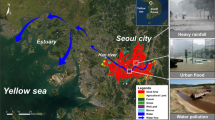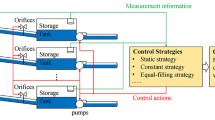Abstract
Stimulated by the recent USEPA’s green stormwater infrastructure (GSI) guidance and policies, GSI systems have been widely implemented in the municipal area to control the combined sewer overflows (CSOs), also known as low impact development (LID) approaches. To quantitatively evaluate the performance of GSI systems on CSO and urban flooding control, USEPA-Stormwater Management Model (SWMM) model was adopted in this study to simulate the behaviors of GSI systems in a well-developed urban drainage area, PSW45, under different circumstances. The impact of different percentages of stormwater runoff transported from impervious surfaces to the GSI systems on CSO and urban flooding control has also been investigated. Results show that with current buildup, GSI systems in PSW45 have the best performance for low intensity and short duration events on both volume and peak flow reductions, and have the worst performance for high intensity and long duration events. Since the low intensity and short duration events are dominant from a long-term perspective, utilizing GSI systems is considered as an effective measure of CSO control to meet the long-term control strategy for PSW45 watershed. However, GSI systems are not suitable for the flooding control purpose in PSW45 due to the high occurrence possibility of urban flooding during or after high intensity events where GSI systems have relatively poor performance no matter for a short or long duration event.

Similar content being viewed by others
References
Qin H P, Li Z X, Fu G. The effects of low impact development on urban flooding under different rainfall characteristics. Journal of Environmental Management, 2013, 129: 577–585
Schmitt T G, Thomas M, Ettrich N. Analysis and modeling of flooding in urban drainage systems. Journal of Hydrology (Amsterdam), 2004, 299(3–4): 300–311
Chen B, Liu J, She N, Xu K. Optimization of low impact development facilities in Beijing CITIC complex. In: Proceedings of International Low Impact Development Conference 2015, 2015, 342–351
Common Wealth of Pennnsylvania Department of Environmental Protection. Pennsylvania Code, Title 25 Environmental Protection, Chapter 93 Water Quality Standards Version: (324889) No. 388. 2007
Pensylvania Department of Environmental Protection. Pennsylvania Integrated Water Quality Monitoring and Assessment Report, 2004
Philadelphia Water Department. The City of Philadelphia’s Program for Combined Sewer Overflow Control—Long Term Control Plan Update, 2009
Kambites C, Owen S. Renewed prospects for green infrastructure planning in the UK. Planning Practice and Research, 2006, 21(4): 483–496
Marty M, Rusty T. Low Impact Development Manual for Arkansas, 2010
Myers R D, Smullen J, Cromwell J, Raucher B, Cammarata M. Balancing green and traditional infrastructure for sustainable urban wet weather management. SIWW Paper, 2009
Robert N S, Long G, Jaffee J. Assessment of the economic impact of additional combined sewer overflow controls in the massachusetts water resource authority service area. Analysis Group Incorporated, 2004, 13
U.S. Environmental Protection Agency (US EPA). Combined sewer overflow (CSO) control policy. Federal Register, 1994, 75(59): 18688–18698
Pieschek R L, Carpenter D D. Modeling green infrastructure in the support of the re-development of Detroit’s neighborhoods. In: Proceedings of World Environmental and Water Resources Congress 2016, 247–254
Lucas W C, Sample D J. Reducing combined sewer overflows by using outlet controls for Green Stormwater Infrastructure: case study in Richmond, Virginia. Journal of Hydrology (Amsterdam), 2015, 520: 473–488
Liu W, Chen W, Peng C. Assessing the effectiveness of green infrastructures on urban flooding reduction: a community scale study. Ecological Modelling, 2014, 291: 6–14
McCutcheon M, Wride D, Reinicke J. An evaluation of modeling green infrastructure using LID controls. Journal of Water Management Modeling, R245–12, 2012, 193–205
Pitt R, Voorhees J, Clark S. Integrating green infrastructure into a combined sewer service area model. In: Proceedings of World Environmental and Water Resources Congress 2010. Challenges of Change, 2010, 2950–2963
York C, Goharian E, Burian S J. Impacts of large-scale stormwater green infrastructure implementation and climate variability on receiving water response in the Salt Lake City area. American Journal of Environmental Sciences, 2015, 11(4): 278–292
Jayasooriya V M, Ng A W M. Tools for modeling of stormwater management and economics of green infrastructure practices: a review. Water, Air, and Soil Pollution, 2014, 225(8): 2055-2061
Huber W C, Dickinson R E. Stormwater management model user's manual. Version 4, EPA/600/3–88/001a (NTIS PB88–236641/AS). Athens, GA: Environmental Protection Agency, 1988
USEPA. Computer tools for sanitary sewer system capacity analysis and planning. EPA/600/R-07/111, National Risk Management Research Laboratory, Office of Research and Development, U.S. Environmental Protection Agency, 2007
USEPA. Storm water management model reference manual volume I—Hydrology (Revised), EPA/600/R-15/162A, U.S. Environmental Protection Agency, 2016
Zimmer A, Schmidt A, Ostfeld A, Minsker B. Computationally implicit hydraulics for real-time combined sewer overflow modeling and decision support. In: Proceedings of World Environmental and Water Resources Congress 2012, 295–304
Abi Aad M, Suidan M T, Shuster WD. Modeling techniques of best management practices: rain barrels and rain gardens using EPA SWMM-5. Journal of Hydrologic Engineering, 2009, 15(6): 434–443
Zhang S, Guo Y. SWMM simulation of the storm water volume control performance of permeable pavement systems. Journal of Hydrologic Engineering, 2014, 20(8): 06014010
Zhang G, Hamlett J, Saravanapavan T. Representation of low impact development scenarios in SWMM, Journal of Water Management Modeling, 2010, R236–12, 183–196
Ormsbee L. Rainfall Disaggregation Model for Continuous Hydrologic Modeling. Journal of Hydraulic Engineering, 1989, 115(4), 507–525
Sun N, Hall M, Hong B, Zhang L. Impact of SWMM catchment discretization: Case study in Syracuse, New York. Journal of Hydrologic Engineering, 2012, 19(1): 223–234
Edwards T K, Glysson G D. Field Methods for Measurement of Fluvial Sediment. U.S. Geological Survey Open-File Report, 1988, 118, 86–531
Rawls W J, Brakensiek D L, Miller N. Green-Ampt infiltration parameters from soils data. Journal of Hydraulic Engineering, 1983, 109(1): 62–70
Feng Y, Burian S, Pomeroy C. ET influence on urban stormwater runoff estimation. In: ASCE Proceedings of World Environmental and Water Resources Congress 2013, 2013, 154–163
Muleta MK. Uncertainty analysis and calibration of SWMMusing a formal, Bayesian methodology. In: Proceedings of World Environmental and Water Resources Congress 2012, 2012, 562–568
Barco J, Wong K M, Stenstrom M K. Automatic calibration of the U.S. EPA SWMM Model for a large urban catchment. Journal of Hydraulic Engineering, 2008, 134(4): 466–474
Author information
Authors and Affiliations
Corresponding author
Rights and permissions
About this article
Cite this article
Tao, J., Li, Z., Peng, X. et al. Quantitative analysis of impact of green stormwater infrastructures on combined sewer overflow control and urban flooding control. Front. Environ. Sci. Eng. 11, 11 (2017). https://doi.org/10.1007/s11783-017-0952-4
Received:
Revised:
Accepted:
Published:
DOI: https://doi.org/10.1007/s11783-017-0952-4




